Guoliang Xing
SHADE-AD: An LLM-Based Framework for Synthesizing Activity Data of Alzheimer's Patients
Mar 03, 2025



Abstract:Alzheimer's Disease (AD) has become an increasingly critical global health concern, which necessitates effective monitoring solutions in smart health applications. However, the development of such solutions is significantly hindered by the scarcity of AD-specific activity datasets. To address this challenge, we propose SHADE-AD, a Large Language Model (LLM) framework for Synthesizing Human Activity Datasets Embedded with AD features. Leveraging both public datasets and our own collected data from 99 AD patients, SHADE-AD synthesizes human activity videos that specifically represent AD-related behaviors. By employing a three-stage training mechanism, it broadens the range of activities beyond those collected from limited deployment settings. We conducted comprehensive evaluations of the generated dataset, demonstrating significant improvements in downstream tasks such as Human Activity Recognition (HAR) detection, with enhancements of up to 79.69%. Detailed motion metrics between real and synthetic data show strong alignment, validating the realism and utility of the synthesized dataset. These results underscore SHADE-AD's potential to advance smart health applications by providing a cost-effective, privacy-preserving solution for AD monitoring.
SocialMind: LLM-based Proactive AR Social Assistive System with Human-like Perception for In-situ Live Interactions
Dec 05, 2024Abstract:Social interactions are fundamental to human life. The recent emergence of large language models (LLMs)-based virtual assistants has demonstrated their potential to revolutionize human interactions and lifestyles. However, existing assistive systems mainly provide reactive services to individual users, rather than offering in-situ assistance during live social interactions with conversational partners. In this study, we introduce SocialMind, the first LLM-based proactive AR social assistive system that provides users with in-situ social assistance. SocialMind employs human-like perception leveraging multi-modal sensors to extract both verbal and nonverbal cues, social factors, and implicit personas, incorporating these social cues into LLM reasoning for social suggestion generation. Additionally, SocialMind employs a multi-tier collaborative generation strategy and proactive update mechanism to display social suggestions on Augmented Reality (AR) glasses, ensuring that suggestions are timely provided to users without disrupting the natural flow of conversation. Evaluations on three public datasets and a user study with 20 participants show that SocialMind achieves 38.3% higher engagement compared to baselines, and 95% of participants are willing to use SocialMind in their live social interactions.
Asteroid: Resource-Efficient Hybrid Pipeline Parallelism for Collaborative DNN Training on Heterogeneous Edge Devices
Aug 15, 2024
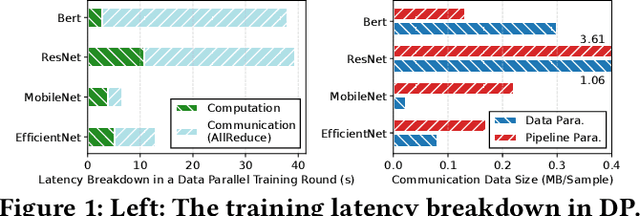
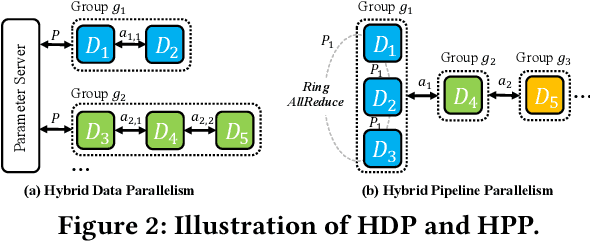

Abstract:On-device Deep Neural Network (DNN) training has been recognized as crucial for privacy-preserving machine learning at the edge. However, the intensive training workload and limited onboard computing resources pose significant challenges to the availability and efficiency of model training. While existing works address these challenges through native resource management optimization, we instead leverage our observation that edge environments usually comprise a rich set of accompanying trusted edge devices with idle resources beyond a single terminal. We propose Asteroid, a distributed edge training system that breaks the resource walls across heterogeneous edge devices for efficient model training acceleration. Asteroid adopts a hybrid pipeline parallelism to orchestrate distributed training, along with a judicious parallelism planning for maximizing throughput under certain resource constraints. Furthermore, a fault-tolerant yet lightweight pipeline replay mechanism is developed to tame the device-level dynamics for training robustness and performance stability. We implement Asteroid on heterogeneous edge devices with both vision and language models, demonstrating up to 12.2x faster training than conventional parallelism methods and 2.1x faster than state-of-the-art hybrid parallelism methods through evaluations. Furthermore, Asteroid can recover training pipeline 14x faster than baseline methods while preserving comparable throughput despite unexpected device exiting and failure.
DrHouse: An LLM-empowered Diagnostic Reasoning System through Harnessing Outcomes from Sensor Data and Expert Knowledge
May 21, 2024Abstract:Large language models (LLMs) have the potential to transform digital healthcare, as evidenced by recent advances in LLM-based virtual doctors. However, current approaches rely on patient's subjective descriptions of symptoms, causing increased misdiagnosis. Recognizing the value of daily data from smart devices, we introduce a novel LLM-based multi-turn consultation virtual doctor system, DrHouse, which incorporates three significant contributions: 1) It utilizes sensor data from smart devices in the diagnosis process, enhancing accuracy and reliability. 2) DrHouse leverages continuously updating medical databases such as Up-to-Date and PubMed to ensure our model remains at diagnostic standard's forefront. 3) DrHouse introduces a novel diagnostic algorithm that concurrently evaluates potential diseases and their likelihood, facilitating more nuanced and informed medical assessments. Through multi-turn interactions, DrHouse determines the next steps, such as accessing daily data from smart devices or requesting in-lab tests, and progressively refines its diagnoses. Evaluations on three public datasets and our self-collected datasets show that DrHouse can achieve up to an 18.8% increase in diagnosis accuracy over the state-of-the-art baselines. The results of a 32-participant user study show that 75% medical experts and 91.7% patients are willing to use DrHouse.
Soar: Design and Deployment of A Smart Roadside Infrastructure System for Autonomous Driving
Apr 21, 2024
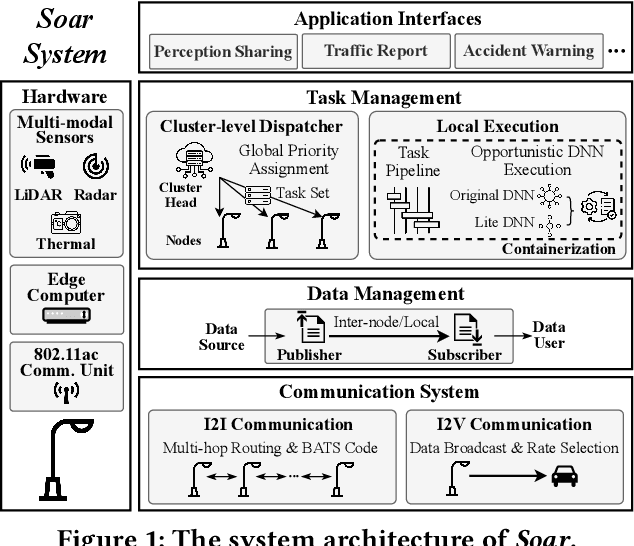
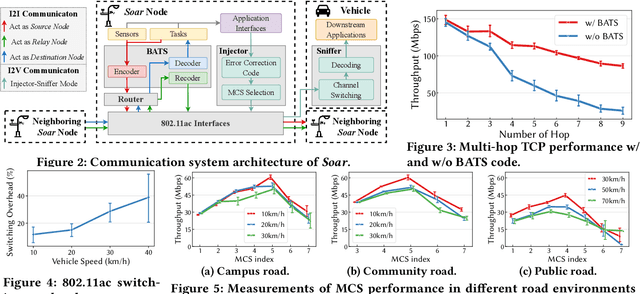
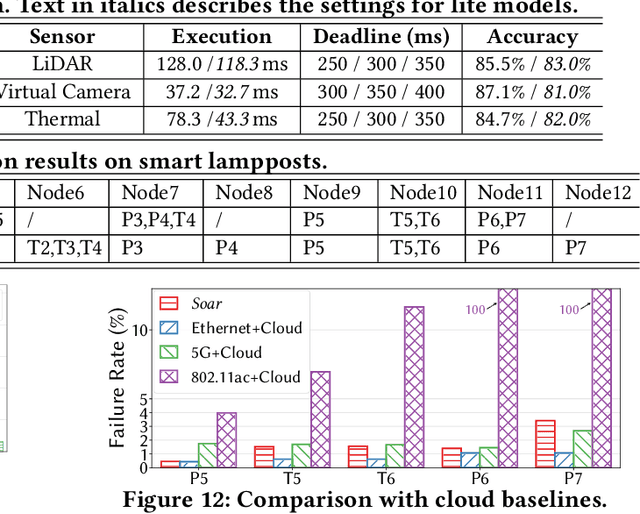
Abstract:Recently,smart roadside infrastructure (SRI) has demonstrated the potential of achieving fully autonomous driving systems. To explore the potential of infrastructure-assisted autonomous driving, this paper presents the design and deployment of Soar, the first end-to-end SRI system specifically designed to support autonomous driving systems. Soar consists of both software and hardware components carefully designed to overcome various system and physical challenges. Soar can leverage the existing operational infrastructure like street lampposts for a lower barrier of adoption. Soar adopts a new communication architecture that comprises a bi-directional multi-hop I2I network and a downlink I2V broadcast service, which are designed based on off-the-shelf 802.11ac interfaces in an integrated manner. Soar also features a hierarchical DL task management framework to achieve desirable load balancing among nodes and enable them to collaborate efficiently to run multiple data-intensive autonomous driving applications. We deployed a total of 18 Soar nodes on existing lampposts on campus, which have been operational for over two years. Our real-world evaluation shows that Soar can support a diverse set of autonomous driving applications and achieve desirable real-time performance and high communication reliability. Our findings and experiences in this work offer key insights into the development and deployment of next-generation smart roadside infrastructure and autonomous driving systems.
Improving the Robustness of Large Language Models via Consistency Alignment
Mar 22, 2024Abstract:Large language models (LLMs) have shown tremendous success in following user instructions and generating helpful responses. Nevertheless, their robustness is still far from optimal, as they may generate significantly inconsistent responses due to minor changes in the verbalized instructions. Recent literature has explored this inconsistency issue, highlighting the importance of continued improvement in the robustness of response generation. However, systematic analysis and solutions are still lacking. In this paper, we quantitatively define the inconsistency problem and propose a two-stage training framework consisting of instruction-augmented supervised fine-tuning and consistency alignment training. The first stage helps a model generalize on following instructions via similar instruction augmentations. In the second stage, we improve the diversity and help the model understand which responses are more aligned with human expectations by differentiating subtle differences in similar responses. The training process is accomplished by self-rewards inferred from the trained model at the first stage without referring to external human preference resources. We conduct extensive experiments on recent publicly available LLMs on instruction-following tasks and demonstrate the effectiveness of our training framework.
VisLingInstruct: Elevating Zero-Shot Learning in Multi-Modal Language Models with Autonomous Instruction Optimization
Feb 12, 2024Abstract:This paper presents VisLingInstruct, a novel approach to advancing Multi-Modal Language Models (MMLMs) in zero-shot learning. Current MMLMs show impressive zero-shot abilities in multi-modal tasks, but their performance depends heavily on the quality of instructions. VisLingInstruct tackles this by autonomously evaluating and optimizing instructional texts through In-Context Learning, improving the synergy between visual perception and linguistic expression in MMLMs. Alongside this instructional advancement, we have also optimized the visual feature extraction modules in MMLMs, further augmenting their responsiveness to textual cues. Our comprehensive experiments on MMLMs, based on FlanT5 and Vicuna, show that VisLingInstruct significantly improves zero-shot performance in visual multi-modal tasks. Notably, it achieves a 13.1% and 9% increase in accuracy over the prior state-of-the-art on the TextVQA and HatefulMemes datasets.
EdgeFM: Leveraging Foundation Model for Open-set Learning on the Edge
Nov 23, 2023



Abstract:Deep Learning (DL) models have been widely deployed on IoT devices with the help of advancements in DL algorithms and chips. However, the limited resources of edge devices make these on-device DL models hard to be generalizable to diverse environments and tasks. Although the recently emerged foundation models (FMs) show impressive generalization power, how to effectively leverage the rich knowledge of FMs on resource-limited edge devices is still not explored. In this paper, we propose EdgeFM, a novel edge-cloud cooperative system with open-set recognition capability. EdgeFM selectively uploads unlabeled data to query the FM on the cloud and customizes the specific knowledge and architectures for edge models. Meanwhile, EdgeFM conducts dynamic model switching at run-time taking into account both data uncertainty and dynamic network variations, which ensures the accuracy always close to the original FM. We implement EdgeFM using two FMs on two edge platforms. We evaluate EdgeFM on three public datasets and two self-collected datasets. Results show that EdgeFM can reduce the end-to-end latency up to 3.2x and achieve 34.3% accuracy increase compared with the baseline.
Knowing What LLMs DO NOT Know: A Simple Yet Effective Self-Detection Method
Oct 27, 2023Abstract:Large Language Models (LLMs) have shown great potential in Natural Language Processing (NLP) tasks. However, recent literature reveals that LLMs generate nonfactual responses intermittently, which impedes the LLMs' reliability for further utilization. In this paper, we propose a novel self-detection method to detect which questions that a LLM does not know that are prone to generate nonfactual results. Specifically, we first diversify the textual expressions for a given question and collect the corresponding answers. Then we examine the divergencies between the generated answers to identify the questions that the model may generate falsehoods. All of the above steps can be accomplished by prompting the LLMs themselves without referring to any other external resources. We conduct comprehensive experiments and demonstrate the effectiveness of our method on recently released LLMs, e.g., Vicuna, ChatGPT, and GPT-4.
ADMarker: A Multi-Modal Federated Learning System for Monitoring Digital Biomarkers of Alzheimer's Disease
Oct 23, 2023



Abstract:Alzheimer's Disease (AD) and related dementia are a growing global health challenge due to the aging population. In this paper, we present ADMarker, the first end-to-end system that integrates multi-modal sensors and new federated learning algorithms for detecting multidimensional AD digital biomarkers in natural living environments. ADMarker features a novel three-stage multi-modal federated learning architecture that can accurately detect digital biomarkers in a privacy-preserving manner. Our approach collectively addresses several major real-world challenges, such as limited data labels, data heterogeneity, and limited computing resources. We built a compact multi-modality hardware system and deployed it in a four-week clinical trial involving 91 elderly participants. The results indicate that ADMarker can accurately detect a comprehensive set of digital biomarkers with up to 93.8% accuracy and identify early AD with an average of 88.9% accuracy. ADMarker offers a new platform that can allow AD clinicians to characterize and track the complex correlation between multidimensional interpretable digital biomarkers, demographic factors of patients, and AD diagnosis in a longitudinal manner.
 Add to Chrome
Add to Chrome Add to Firefox
Add to Firefox Add to Edge
Add to Edge